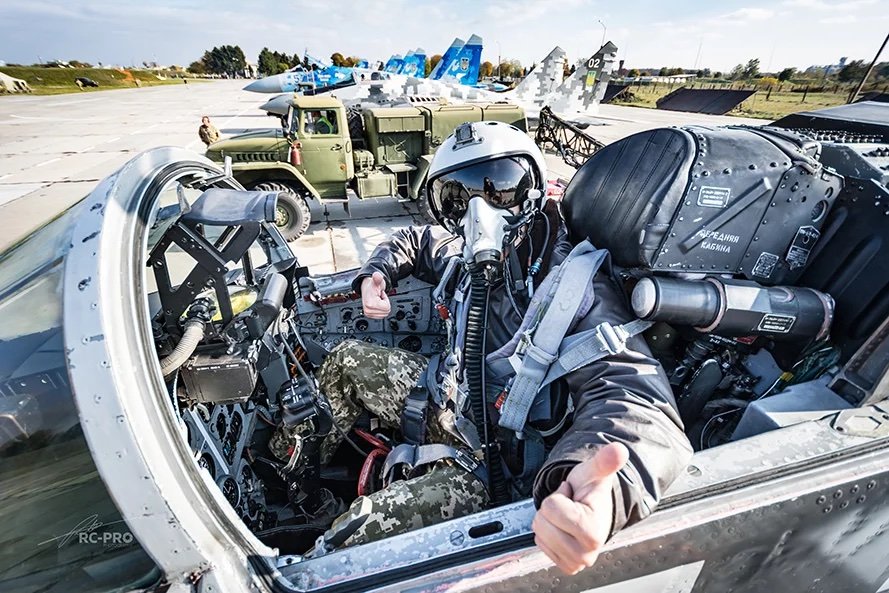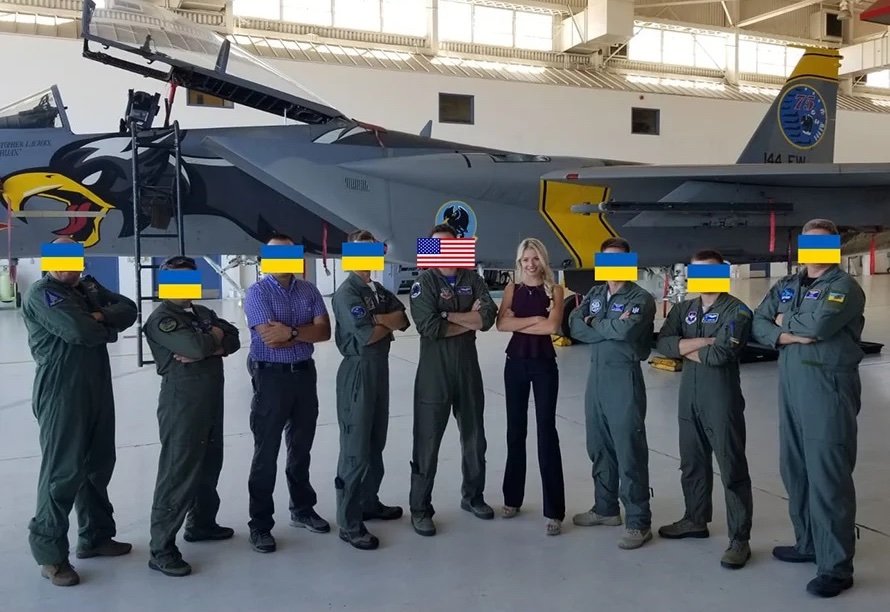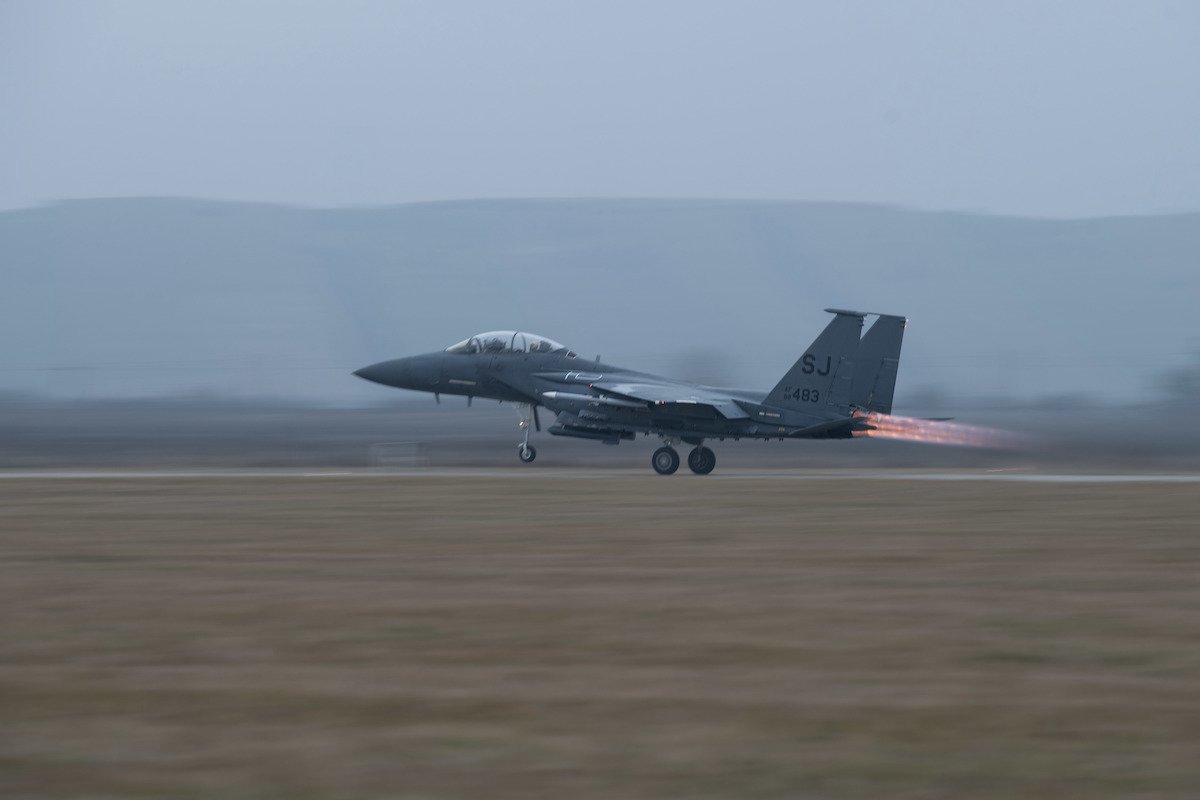‘Grey Wolf Team’: How a USAF Task Force Works To Keep Ukraine’s Pilots Fighting

A Ukrainian pilot gives a thumbs-up. A US Air Force group, dubbed "Grey Wolf Team," has been established in Germany to determine what technology, weapons, and tactics the US can send to Ukraine to aid its air force. Picture from wingmenforukraine.com.
An ad hoc US Air Force task force known as the “Grey Wolf Team” is advising Ukraine’s air force in its defensive air campaign against Russia’s invasion.
“We exist because there’s a bunch of motivated people who want to help out. There’s not another team like this in the Air Force that’s doing the same thing,” said an Air Force fighter pilot who has worked extensively on the Grey Wolf Team.
Named in honor of Col. Oleksandr “Grey Wolf” Oksanchenko, a legendary Ukrainian pilot killed in the war’s opening days, and based at Ramstein Air Base in Germany, the Grey Wolf Team focuses on understanding the limited technological tools available to the Ukrainians, whose air force comprises mostly Soviet-era hardware. With input from Ukrainian counterparts, the team passes recommendations up the Department of Defense’s chain of command for “low-cost, game-changing” solutions to Ukraine’s air combat challenges, one team member told Coffee or Die Magazine.

Those suggestions include proposals for equipment deliveries, as well as the transfer of tactics and techniques to Ukrainian air force pilots and support personnel, which can then be immediately used in combat.
“Knowing their pilots, knowing their aircraft […] we decide what we can reasonably ‘onboard’ and execute in order to create effects on the battlefield,” said the pilot, who asked that his name not be published due to the sensitive nature of his work.
Rule Benders
The Grey Wolf Team operates from the floor of the US Air Forces in Europe, or USAFE, air operations center at Ramstein. Typically with five to eight members, the team is entirely composed of US Air Force personnel, including fighter pilots, air battle managers, intelligence personnel, and others from specialties that can help.
“We are able to see a lot of the intelligence, up to a pretty classified level, and be able to make assessments on what Ukraine’s air force needs to succeed from an air component perspective,” the team member said. “I may not be able to share much of those details with the Ukrainians, at least not initially, because they come from classified sources, but I nevertheless get a lot of information from the Ukrainians about what their actual needs are, what their problem sets are.”
Service on the Grey Wolf Team is voluntary, and members are typically requested by name. There is no other such group in the US Air Force, and no template exists for the team’s unique mission, which began only after Russia’s Feb. 24 full-scale invasion. To achieve its goals, the Grey Wolf Team promotes ingenuity and forward thinking among its members — akin, in some ways, to the creative culture of a Silicon Valley startup.

“This is the weirdest job I’ve had in the military. It’s sort of a ‘choose your own adventure,’” said the team member, who has flown both F-16 and F-15 fighters. “It’s also kind of a roller coaster of emotion because, on the one hand, you have the freedom to go do anything, and on the other you have this feeling like, ‘What am I missing?’”
The team’s recommendations travel up the Pentagon’s chain of command and sometimes reach lawmakers’ desks in Washington. The group has gotten “a few little things across the finish line,” but “work continues to be ongoing,” the team member said.
Sometimes the Ukrainians ask for a weapon that either can’t be used on a Soviet-era jet or the US is unable to provide. In those cases, the Grey Wolf Team examines what combat effect the Ukrainians are pursuing in their ask, and then effectively work backward from there to find a solution based on available technology.
“Some things are non-starters,” the team member said. “I can’t put an AIM-120 [an advanced air-to-air missile carried by US fighters] on a Ukrainian jet. But other things aren’t so complicated and could provide an outsized capability.”
Limitations
One Ukrainian air force liaison officer is stationed at USAFE headquarters at Ramstein Air Base. An Su-24 pilot who speaks fluent English and flew in combat after the Feb. 24 full-scale invasion, this officer’s role is to bridge the differences in institutional culture between the US and Ukrainian air forces. He’s also instrumental in helping the Americans understand the Ukrainians’ technological limitations.
“We have to be really careful about telling [the Ukrainians] how to do things,” the Grey Wolf Team member told Coffee or Die. “Because I don’t know how all their systems work, and how their military works, and I don’t want to tell them the wrong thing. So having this gentleman, who was recently high up as a pilot, has combat experience, and who also knows how [the Ukrainian] military works, that’s huge for us at USAFE. To be able to have someone who can translate, not just language, but translate how the militaries work differently from each other.”
Although the Ukrainian military has migrated away from the Soviet Union’s strict, top-down chain-of-command culture, Ukrainian pilots do not enjoy the same amount of decision-making autonomy as American combat pilots. One reason for this difference is that the avionics used in the Ukrainians’ Soviet-era jets have slowed the transition to more decentralized operations.

“[The Ukrainians] put more emphasis on the ground control, and their command and control, to direct their pilots what to do,” said Drew Armey, an F-15 pilot in the California Air National Guard who has worked with Ukraine’s air force since 2015. “I would call their doctrine somewhere between Russian and US doctrine. Their avionics are not set up the same as ours, to allow as much autonomous operation of the individual pilot.”
Thanks to the advanced avionics in US warplanes, which provide a large amount of information inside the cockpit, US combat pilots are usually the final decision authority when it comes to using their weapons. Compared with their American counterparts, Ukrainian combat pilots have access to less information, leaving them more reliant on ground-based command and control personnel.
“Western cockpits and displays are very built around the idea that the pilot is going to be the central decision-making authority in his jet,” Armey said, adding:
“And our air battle management, our AWACs, is telling me information for me to make a decision. Predominantly, they don’t tell me what to do. […] I’m ultimately going to be that decision-making authority. But I also have more ability in my cockpit to have awareness so I can make that decision. It’s difficult in [the Ukrainians’] cockpits […] their avionics are limiting, so there’s a physical reason why they do things a little bit differently than us.”
Relationships
Several US Air Force personnel spearheaded the Grey Wolf Team concept in the final days before Russia’s Feb. 24 full-scale invasion. At the heart of the team’s creation was Col. Robert Swertfager, commander of the 144th Operations Group within the California Air National Guard’s 144th Fighter Wing.
Swertfager was friends with Ukraine’s “Grey Wolf,” Oksanchenko. The 53-year-old Su-27 pilot was shot down and killed by Russian anti-air defenses on Feb. 25. One of Ukraine’s most revered military pilots, Oksanchenko had left retirement to fly combat missions.
“He was a huge personality and highly respected,” Armey said.
The California Air National Guard’s 144th Fighter Wing has worked with the Ukrainian air force since 1993, and over that time many close friendships have formed. Armey said he has about 10 Ukrainian pilots’ numbers stored on his phone, one of whom — an Su-24 pilot — has been to Armey’s house for dinner.
Soon after the Feb. 24 invasion began, Armey went looking for ways to help.

“I think I was losing sanity without more of an ability to help out,” Armey told Coffee or Die. “Sitting on the sidelines and not doing anything was kind of devastating, after having friends [in Ukraine] and working with their military for years.”
With his wife, Anastasiia, who is Ukrainian, Armey created a fundraising site called “Wingmen for Ukraine,” which purchases gear for the Ukrainian military, including some specific equipment for Ukrainian pilots such as survival radios. The couple collaborated with Jonathan Burd, who is a former F-15 pilot with the call sign “Jersey,” and historian and author Adam Makos.
“Things that seem very small to us, like sending a guy a pair of combat boots, can have a very outsized effect,” Armey said. “We can’t go fight the war, but at least we can help in various ways. […] The [Ukrainians] are extremely worthy to be invested in.”

Those long-standing personal relationships spurred the California Air National Guard’s fighter pilots to immediately take the lead in supporting Ukraine’s air force after the Feb. 24 invasion. In particular, the Grey Wolf Team’s success to date has hinged on the decadeslong partnership between Ukraine’s air force and the California Air National Guard.
For its part, the Ukrainian air force has shown both a willingness and an ability to rapidly incorporate new technologies and tactics into their combat operations.
Sometimes there’s a bit of a back and forth when the American fighter pilots suggest that the Ukrainians change their tactics or techniques — highly skilled operators inherently take pride in the way they do things. But all those years of working together, training together, and passing time together as colleagues and friends have inspired the Ukrainians to take the Americans’ recommendations to heart — and then put them into practice in combat, when able.
“We have consistently underestimated the Ukrainian armed forces in general, but particularly their air force and their ability to adapt to new tactics and new weapons,” Armey told Coffee or Die.
“[The Ukrainians] continue to be adaptable,” he said. “They continue to surprise me with their ability to adapt to new tactics, to continue to exploit [Russia’s] weaknesses, and to continue to make those updates and changes. Whatever information we give them — and it’s been fairly limited — but whatever we are able to give, we see positive effects every single time.”
Speaking specifically about Ukrainian Su-24 pilots, who fly extremely low to avoid Russian air defenses, Armey said, “Their ability to get in there and do the mission is incredible.”
Hard to Kill
One of the most important things the Ukrainian air force did in the early days of the full-scale war was to constantly move around its jets and anti-aircraft systems, making them harder targets for Russian airstrikes and missiles. Thanks to that mobility, Ukraine’s air force remains able to contest most of its airspace and even maintains air superiority over a large swath of its skies.
An exception was over the city of Mariupol, where Russia was able to achieve approximate air superiority. The outcome of that battle offers a stark lesson in the air war’s importance to ground operations.
“It was indiscriminate bombing by the Russians 24 hours a day in Mariupol. […] They were free to use very poor bombing with unguided munitions, and have an effect on the battlefield because Ukraine wasn’t able to contest the airspace,” Armey said.
“Ultimately, the conditions for the defenders in Mariupol were absolutely horrendous, and I would attribute that to the fact that Russia had complete air superiority,” he added. “That’s not the only reason, but that is a compelling reason why the conditions got so absolutely terrible there.”

According to US Air Force personnel who spoke with Coffee or Die, the Russians have been relatively successful at protecting their ground forces with tactical surface-to-air missiles, or TACSAMs, which provide short-range anti-air defenses at lower altitudes. In addition to the more far-reaching, high-altitude air defense systems employed by the Russians, that means Ukrainian war planes are largely unable to operate at any altitude near Russian ground units.
Yet, the air defense threat goes both ways, and Russia’s overall offensive air war against Ukraine has been hindered by a lack of stealthy, fifth-generation fighters.
Apart from the reported use of several fifth-generation Su-57 fighters, Russia’s air campaign against Ukraine has relied on aircraft like the Su-34 and Su-35 fighters, which aviation experts consider to be so-called generation 4.5 aircraft. Russia has also flown fourth-generation fighters, as well as older warplanes like the Su-25. In any case, these nonstealthy warplanes have proven vulnerable to Ukraine’s air defenses.
“If we were to look at the threat laid out in Ukraine, [the US Air Force] would use a lot of fifth-generation fighters there,” Armey said. “With the fourth-generation air threat that Ukraine is able to put up, it is a hard problem in a fourth-gen fighter.”
Even modern US fighters, said Armey, often struggle against Russian-like air defenses in air combat exercises at Nellis Air Force Base in Nevada. “This is what we do at Red Flag […] but I can tell you that we take losses, significant losses in taking down those systems in training — that integrated air defense. It’s hard to do.”
“Russia doesn’t train like this,” Armey added. “Russia has consistently undervalued the importance of training. So [Ukraine’s air defenses] are a very difficult problem for somebody who has never trained against that level of sophistication.”
Stalemate
Air defenses have limited the operations of both sides’ warplanes. Effectively, neither air force has been able to safely operate within the shadow of their opponent’s surface-to-air missiles, which has left a deadlocked air war. In order to maintain that status quo, Ukraine needs the tools and training to sustain its defensive air campaign over the long haul.
“If Ukraine loses the ability to contest its airspace […] the ground campaign is going to go very poorly,” Armey said. “There’s effectively a stalemate in the air where the Ukrainians won’t go [over Russian lines] and the Russians won’t really go over the top of Ukrainian-controlled territory with their aircraft. If that situation is lost, this war will not go well. We can’t just neglect that aspect of the war, and I would argue we kind of have been.”
The ground war’s front lines have largely stagnated. Even so, the Ukrainian air force’s lack of reliable standoff weapons has prevented it from carrying out long-range strikes against Russia’s relatively static positions in eastern and southern Ukraine.

Standoff weapons strike targets from a long distance, meaning warplanes don’t need to directly overfly a target and can therefore stay outside the range of an adversary’s air defenses. Ukraine has some domestically made standoff weapons, but “they’re not working really well,” Armey said.
“Their percentage of working [standoff] munitions is low, unfortunately,” he said. “That drives their request for Western munitions, to see if we’ve got the ability to integrate something that’s simpler but creates that standoff capability on their jets.”
US Air Force personnel who spoke with Coffee or Die said the close collaboration between US and Ukrainian fighter pilots through the Grey Wolf Team has produced some important lessons in modern air warfare for the American side. Yet, rather than challenging any preexisting ideas, the Russians’ lackluster air combat performance has, to date, largely confirmed the merits of existing American air power doctrine and tactics.
When asked if the Russian air force’s relatively poor performance against Ukraine has spurred him to reevaluate any of his own air combat thinking, Armey replied, “It’s not like I’m going to change my tactics to go after the least common denominator.”
Read Next:

BRCC and Bad Moon Print Press team up for an exclusive, limited-edition T-shirt design!
BRCC partners with Team Room Design for an exclusive T-shirt release!
Thirty Seconds Out has partnered with BRCC for an exclusive shirt design invoking the God of Winter.
Lucas O'Hara of Grizzly Forge has teamed up with BRCC for a badass, exclusive Shirt Club T-shirt design featuring his most popular knife and tiomahawk.
Coffee or Die sits down with one of the graphic designers behind Black Rifle Coffee's signature look and vibe.
Biden will award the Medal of Honor to a Vietnam War Army helicopter pilot who risked his life to save a reconnaissance team from almost certain death.
Ever wonder how much Jack Mandaville would f*ck sh*t up if he went back in time? The American Revolution didn't even see him coming.
A nearly 200-year-old West Point time capsule that at first appeared to yield little more than dust contains hidden treasure, the US Military Academy said.












